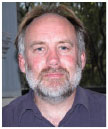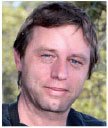Articles citing this paper
The formation and fate of organoarsenic species in marine ecosystems: do existing experimental approaches appropriately simulate ecosystem complexity?
Elliott G. Duncan A B , William A. Maher A and Simon D. Foster A
+ Author Affiliations
- Author Affiliations
A Ecochemistry Laboratory, Institute for Applied Ecology, University of Canberra, University Drive, Bruce, ACT 2601, Australia.
B Corresponding author. Present address: CSIRO Agriculture, Centre for Environment and Life Sciences, Underwood Avenue, Floreat, WA 6014, Australia. Email: elliott.duncan@csiro.au

Elliott Duncan (B.Res.Env.Sci. 2007, Hons 1st class 2008, Ph.D. 2013) is a postdoctoral researcher at CSIRO Agriculture. Previously he undertook Ph.D. studies in the Ecochemistry Laboratory, Institute of Applied Ecology at the University of Canberra. His research interests include the biogeochemical cycling of arsenic and other metalloids in marine ecosystems focussing on organisms at the bottom of marine food-webs (e.g. unicellular algae, microbiota).
|

Bill Maher (M.App.Sci. 1977, Ph.D. 1981) is a professor in Environmental/Analytical Chemistry at the University of Canberra. His research interests are the biogeochemical cycling of trace metals, metalloids and nutrients in aquatic ecosystems, development of water quality and sampling guidelines and development of analytical procedures for measuring trace contaminants in water, sediment and biota. He is also director of the Ecochemistry Laboratory, Institute of Applied Ecology at the University of Canberra. He was awarded the RACI Analytical Divisions medal in 2002 and the RACI Environmental Chemistry Divisions medal in 2004.
|

Simon Foster (B.Earth&LandSci. 2002, Hons 1st 2003, Ph.D. 2008) is an Assistant Professor in Environmental/Analytical Chemistry at the University of Canberra. He undertook Ph.D. studies in the Ecochemistry Laboratory, Institute of Applied Ecology at the University of Canberra. His research interests are in the cycling of trace metals and metalloids in organisms, and development and application of methods for the measurement of chemical species in environmental samples.
|
Environmental Chemistry 12(2) 149-162 https://doi.org/10.1071/EN14124
Submitted: 1 July 2014 Accepted: 17 October 2014 Published: 25 March 2015
Toxicity of arsenic(
Golding Lisa A.,
Valdivia Maria V.,
van Dam Joost W.,
Batley Graeme E.,
Apte Simon C., Wilkinson Kevin
Environmental Chemistry. 2022 19(4). p.116
Arsenobetaine: the ongoing mystery
Popowich Aleksandra,
Zhang Qi, Le X. Chris
National Science Review. 2016 3(4). p.451
Sargassum contamination and consequences for downstream uses: a review
Devault Damien A.,
Pierre Ronan,
Marfaing Hélène,
Dolique Franck, Lopez Pascal-Jean
Journal of Applied Phycology. 2021 33(1). p.567
Factors influencing arsenic concentrations and species in mangrove surface sediments from south-east NSW, Australia
Hettiarachchi S. R.,
Maher W. A.,
Krikowa F., Ubrihien R.
Environmental Geochemistry and Health. 2017 39(1). p.209
Effects of Dietary Intake of Arsenosugars and Other Organic Arsenic Species on Studies of Arsenic Methylation Efficiency in Humans
Davydiuk Tetiana,
Tao Jeffrey,
Lu Xiufen, Le X. Chris
Environment & Health. 2023 1(4). p.236
Strategies for the analysis of arsenolipids in marine foods: A review
Coniglio Davide,
Ventura Giovanni,
Calvano Cosima D.,
Losito Ilario, Cataldi Tommaso R.I.
Journal of Pharmaceutical and Biomedical Analysis. 2023 235 p.115628
Arsenic bioaccumulation and biotransformation in deep-sea hydrothermal vent organisms from the PACMANUS hydrothermal field, Manus Basin, PNG
Price Roy E.,
Breuer Christian,
Reeves Eoghan,
Bach Wolfgang, Pichler Thomas
Deep Sea Research Part I: Oceanographic Research Papers. 2016 117 p.95
Arsenic species in mesopelagic organisms and their fate during aquafeed processing
Tibon Jojo,
Amlund Heidi,
Gomez-Delgado Ana I.,
Berntssen Marc H.G.,
Silva Marta S.,
Wiech Martin,
Sloth Jens J., Sele Veronika
Chemosphere. 2022 302 p.134906
Arsenic Speciation in Algae (2019)
Chen Lizhao, Zhang Li
Atomic Spectrometry Update: review of advances in elemental speciation
Clough Robert,
Harrington Chris F.,
Hill Steve J.,
Madrid Yolanda, Tyson Julian F.
Journal of Analytical Atomic Spectrometry. 2016 31(7). p.1330
Organoarsenical compounds: Occurrence, toxicology and biotransformation
Chen Jian,
Garbinski Luis D.,
Rosen Barry,
Zhang Jun,
Xiang Ping, Ma Lena Q.
Critical Reviews in Environmental Science and Technology. 2020 50(3). p.217
Speciation of technologically critical elements in the environment using chromatography with element and molecule specific detection
Wojcieszek Justyna,
Szpunar Joanna, Lobinski Ryszard
TrAC Trends in Analytical Chemistry. 2018 104 p.42
Arsenic in edible macroalgae: an integrated approach
Camurati Julieta R., Salomone Vanesa N.
Journal of Toxicology and Environmental Health, Part B. 2020 23(1). p.1





